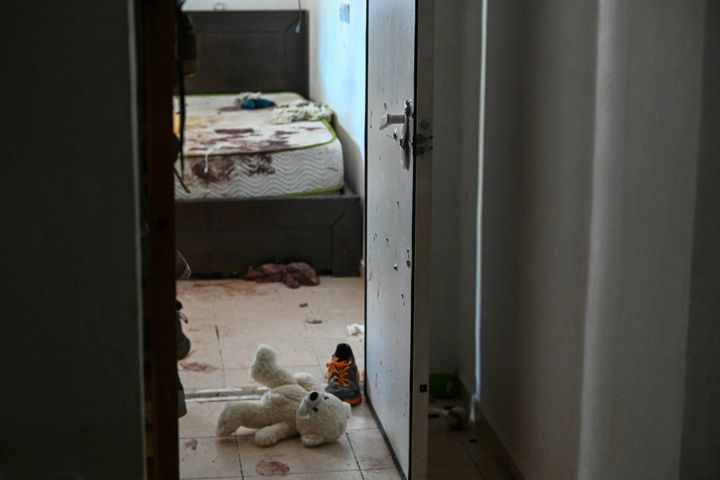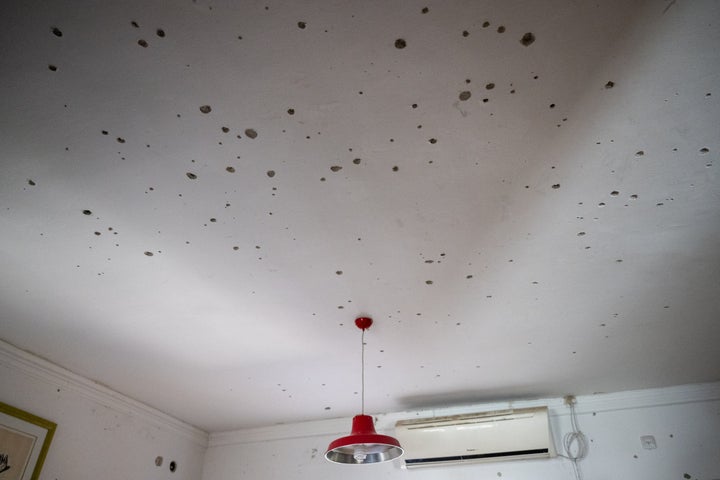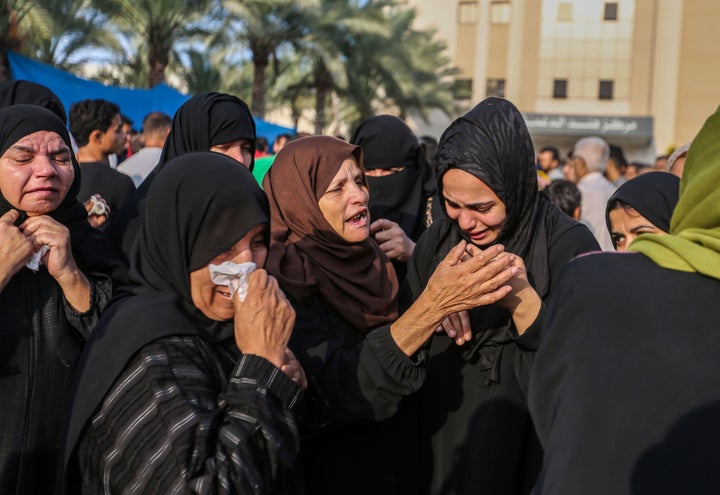
This story contains graphic descriptions of violence and discussions of sexual assault.
The security camera in their backyard caught the man and his young sons in nothing but their underwear. They are running and stepping gingerly at the same time, the father’s leg muscles visible as he and the boys all but sprint across the patio to the shelter door.
A Hamas fighter, decked out in full tactical gear and carrying multiple assault rifles, vaults the fence from the front yard. By this point, the three Israelis have made it to the shelter, but not to safety. The fighter tosses a grenade, and the explosion throws the father’s crumpled body against the shelter entrance. The boys emerge. They are coated in blood; it’s not clear how much of it is their father’s. One boy appears to be missing an eye.
“Daddy’s dead, Shay,” Itay, one of the boys, tells his brother later, inside the house, where a Hamas fighter orders them to stay while he ransacks their refrigerator, briefly offering them water before helping himself to some soda. “It’s really not a prank.”
As the reality sets in, they weep. The one who was blinded sits at a table clutching his face. His brother throws himself to the floor. “Why am I alive? Why am I alive?”
Eventually, they are seen running out of the house. The Israeli Defense Forces confirmed that the boys survived. They are the lucky ones. On Friday afternoon, the IDF screened raw footage of Hamas’ Oct. 7 attack on Israeli civilians, in which some 1,400 people were killed, for an audience of three journalists at a Jewish foundation office in Manhattan.
The videos, which are not being released publicly, were drawn from body cameras worn by Hamas fighters who were killed in the subsequent clashes with Israeli security forces. They also include footage from CCTV cameras and from the Israeli victims’ cellphones, which the terrorists seized and used to livestream their killing and even call their own parents back in Gaza. The military first showed the gruesome 47-minute montage to foreign correspondents at a base in Tel Aviv on Oct. 23, and again to reporters in New York on Oct. 27.
Edited versions of some of the videos had already circulated online, prompting rabbis across the world to urge congregants, particularly children, to temporarily quit social media to avoid the gore. But IDF Lt.-Col. Amnon Shefler says the IDF decided to screen the raw footage to select journalists and diplomats to combat attempts by antisemitic conspiracists, and some critics of Israel’s fierce military campaign in Gaza, to deny or downplay Hamas’ atrocities.
Recent videos in cities such as New York, Boston and London show young people tearing down posters of the nearly 200 children and adults Hamas took hostage in the attack. When confronted, some of them claim the posters ― designed to look like public notices about kidnapped children ― are promoting “fake news,” and that removing them is an act of support for “colonized” Palestinians.
As the IDF has arranged these screenings, Israel’s military campaign in Gaza has killed at least 9,061 Palestinians, including 3,760 children, as of Thursday, according to data from the United Nations. The numbers, which the U.N. said it could not independently verify, come from the Hamas-run Gaza Health Ministry and the Israeli government, but they appear to align with what experts would expect, based on the extent of the bombing in a densely populated area where almost half the population is below the age of 18. Back in 2002, when a raid in Gaza killed 14 civilians, the Israeli military apologized. This time, however, the military has cut off water, food and electricity in the territory, and has bombed refugee camps in acts that have spurred even some of Israel’s most ardent allies to temper what was once unconditional support.
The IDF’s latest screening of the footage took place Friday afternoon in a nearly empty conference room at the offices of the UJA-Federation of New York, a Jewish philanthropy, on 59th Street, a few blocks from Central Park. Though I reported from Israel earlier this year, I have not been actively writing about the war. But when a publicist working for the IDF contacted me Friday morning to ask if I would join the viewing, I agreed, in part to bear witness and to spare a colleague the gruesome task.
Two uniformed IDF officers greeted me in the empty hallway of the foundation’s office, and asked me and the other two journalists to turn our phones off and leave them in a basket outside the conference room where the videos would be played. Shefler, one of the two officers present, said this precaution was necessary to avoid the videos leaking and traumatizing the victims’ families.
The conference room was dark and antiseptic, with dozens of black chairs arranged for our audience of three in front of a large screen. Everyone was silent. No one said hello, or indeed made eye contact. Shefler closed the curtains, then the door.
The montage opens with an explanation that what follows is raw footage collected from a variety of sources and documenting the deaths of at least 138 people, fewer than 10% of the Israelis killed on Oct. 7. The IDF said the montage represents a fraction of the material they have obtained, and that analysts are still combing through all of it. Before any images appeared on the screen, we heard a low droning sound. I thought for a moment it was some kind of ominous soundtrack. It was an engine.

The camera, affixed to the dashboard of a civilian’s silver hatchback, shows a scene of what looks like a professional fighting force of soldiers stopping a car at a checkpoint. A crack in the windshield indicates where the men shot the driver, but the car keeps rolling forward.
Body camera footage recovered from some of those Hamas fighters shows their side of it. It’s early in the morning, and the driver realizes too late that the men standing there are not IDF soldiers. Before he can turn around, they pump dozens of bullets into the car. The driver slumps over, and the car careens into another vehicle. Scenes like this unfold over and over again from the vantage point of traffic cameras, dash cams and the GoPros the Hamas fighters themselves are wearing. They are among the least horrific.
The goriest scenes include shots of at least two babies, their faces blurred but the pink brain matter oozing from the back of their heads visible. We saw a woman in pajamas tangled in her bedsheets and hanging off her mattress, skull fragments and dried blood in her hair. A little girl no older than 8 in her underwear in bed, her arms raised, her head partly blown off. Another little girl about the same age, facedown in bed, shot in the back of the head.
It’s difficult to say whether it was harder to watch the scene of hundreds of festivalgoers running for their lives across an open field like a frightened herd ― I felt both captivated by this unusual image and sick, knowing what was coming next ― or the footage of what became of many of them. A young man films himself and the bloodied bodies of his friends in the building where they are sheltering. He points his phone outside to show the lifeless body of a young woman sprawled on the ground. Everyone still alive is covered in mud and blood and panting in fear. The young man’s face comes into view. His eyes blaze with terror.
Hamas fighters find the man and his friends and drag at least three of them into the back of a pickup truck. One of the Israelis is holding aloft what remains of his mangled arm, perhaps hoping gravity will keep him from bleeding out. Later footage shows the body of another concertgoer, a tall person with locs who was not identified but matches the description of the German-Israeli DJ Shani Louk, stripped to their underwear, facedown in the bed of a pickup. Two fighters are sitting on the body. One of them smiles, his expression like those I’ve seen in photographs of hunters with a slain buck. They appear to have entered Gaza, and people run up to the truck to see the body and spit on it.
In another scene from what appears to be early evening, a fighter comes upon a bullet-riddled car and the dead young woman who tried to escape in it. She’s wearing a skirt and boots, one of which gets briefly caught under the dashboard as he pulls her out by the armpits and throws her slender frame to the ground.
“Woo!” he exclaims, more than once, in the same tone someone might use on a roller coaster.
Later footage from rescue workers’ body cameras shows pits of charred bodies that resemble the debris left behind by wildfires, the blackened limbs stiff in the air like the remnants of incinerated trees. The remains are so burnt it’s impossible to tell how many individual bodies this ghastly amalgam comprises. Not everyone was completely immolated: Another scene shows a young woman lying dead next to a car. Her bare legs, visible beneath her hiked-up skirt, are smudged with dirt and blood. Her face is mutilated, her head half burned, her eyelids and lips gone.
Clips of intercepted audio, aired on black screens with subtitles, offer little reprieve from the grisly violence. On the phone with his commander, a fighter says he is cutting off the heads of victims with a knife. His commander reminds him to photograph the decapitated heads.
That audio is followed by bodycam footage from a fighter looking down at a middle-aged Thai man ― one of the tens of thousands who come from the Southeast Asian nation to work on farms in Israel. He is lying on the concrete outside a building, his yellow T-shirt stained with blood from bullet wounds to his stomach. It’s not clear, at this moment, whether he’s still alive. The fighters decide to behead him. One swings a hoe, striking the man’s neck with a loud thump. He cheers that God is great, and another fighter seizes the garden tool and takes a swing himself. The blade, apparently blunt, does not immediately sever the man’s head. They repeat the process.
A particularly disturbing moment, which has been highlighted in previous reports on the footage, comes only from audio. An excited fighter calls his father in Gaza, pleading with them to check WhatsApp and see the photos he sent. He tells them he is calling from the phone of a dead Jewish woman.
“Your son killed Jews,” the man tells his father. “I killed 10 with my bare hands.”
The father says little, and you can hear the fighter’s mother in the background. He repeats himself over and over again. “Mom, I killed 10 Jews with my own hands,” he says.
The man’s mother shrieks and begins to sob. She can only muster one sentence: “May God bring you back safely.” He seems frustrated that she isn’t joining in his jubilation.
“Mom, your son is a hero,” he insists. “Kill, kill, kill.”
When the video ended, our conference room was silent except for the sounds of deep breaths and pens scribbling. Shefler opened the blinds to reveal the afternoon sun pouring down Lexington Avenue. He plucked a seat from the front row and sat down, turning to face us.
No one said anything for a few minutes. I wrote in my notebook that I envied the audiences who saw this footage with dozens of other people, that the intimacy of this event particularly haunted me.

The images of dead children felt disturbingly familiar, after weeks of watching the horrors of Gazan civilians recovering dead and maimed toddlers from the rubble of bombed apartment buildings. The screams reminded me of the newsreels I’d watched from hospitals in Gaza, where bombing survivors underwent surgery without anesthetics as supplies dwindled. The suddenness of death recalled the videos I’d seen of civilians attempting to evacuate to southern Gaza as the Israeli military ordered, only to be bombed as they fled.
But those images were akin, at least in one way, to other videos I have seen of combat and the targeting of civilians ― in Syria, in Ukraine, in Yemen ― with death arriving faceless, impersonally, from above. There was a different aspect to this footage: the perpetrators’ visible glee, which called to mind the videos shot and released by the Islamic State terrorist group at the height of its power nearly a decade ago.
That insurgency, which seized broad swaths of territory in Iraq and Syria, soared to global infamy in 2014 after publishing a video of one of its prominent British recruits beheading American journalist James Foley with a combat knife. The snuff film was carefully staged; Foley was forced to wear an orange jumpsuit like the uniforms in which the U.S. dresses inmates at Guantanamo Bay.
Subsequent videos from the group followed even crueler designs. A captured Jordanian fighter pilot was burned alive. A group of Iraqi prisoners drowned in a cage that ISIS fighters slowly lowered into water. And yet even those videos were stylized, planned out, slickly presented. By contrast, the montage of footage from so many different cameras and angles and moments on Oct. 7, including scenes of fighters hunting and shooting victims as they tried to hide, felt realer, almost like being there. Realizing this while sitting in the safety of a guarded building in New York brought on a nauseating feeling of guilt.
Eventually I looked up and locked eyes with Shefler, who cleared his throat.
“I’m really sorry you had to watch that,” he said. “I’m more sorry that this happened. That it is happening. I hope it’s another way to understand why we are doing what we believe needs to be done to make sure this never happens again, which means the full dismantling of Hamas.”
I asked if the women whose skirts were hiked up were raped. He said the IDF could not confirm its legal evidence of sexual assault yet, and that many of the bodies are so mutilated by fire and bullets that it has been difficult to identify everyone. But he said a number of female bodies had shattered pelvises, and that many of the women found in their beds were stripped of their clothes before they were shot in the head or chest.
“They likely didn’t go to bed naked,” he said.
When I left, I turned my phone on and started toward my office. It was cool out, and I walked at a brisk pace. I’d tried to maintain my professional restraint, and to remind myself that this is what the Israeli military wanted me to see. Even attending this screening and writing about it made me feel uneasy, the very nature of the event being so one-sided and limited to a single day of killing, when the subsequent weeks had, in sheer quantity, brought so much more death to Palestinians ― as has been the case for decades. (It will likely be the case for decades to come, if for no other reason than the dust from destroyed buildings lodging in human lungs.)
I thought of these things. I thought of the writer John Ganz’s recent essay on the allure of nationalism in the face of violence, and how much I admired his defiant refusal to be recruited, his insistence on remaining a “brother” to “all the different peoples of the world.” But in those first few minutes after leaving the screening, I couldn’t stop myself from feeling angry, succumbing to a flash of what I can only describe as tribal rage. I am Jewish; one of the women in the footage had looked like my little sister.
I called my dad. I told him what I’d seen, half expecting he would stoke those embers with his own fury, to tell me I’d fulfilled my duty in bearing witness and done my small part to keep us safe. At that moment, I wanted more than anything to feel righteous. But instead, when he spoke, his voice quivered in a way I had never heard before. He was afraid. I felt suddenly overwhelmed by a sense of helplessness and shame.
My voice cracked. To my surprise, I began crying uncontrollably in the middle of Fifth Avenue.
